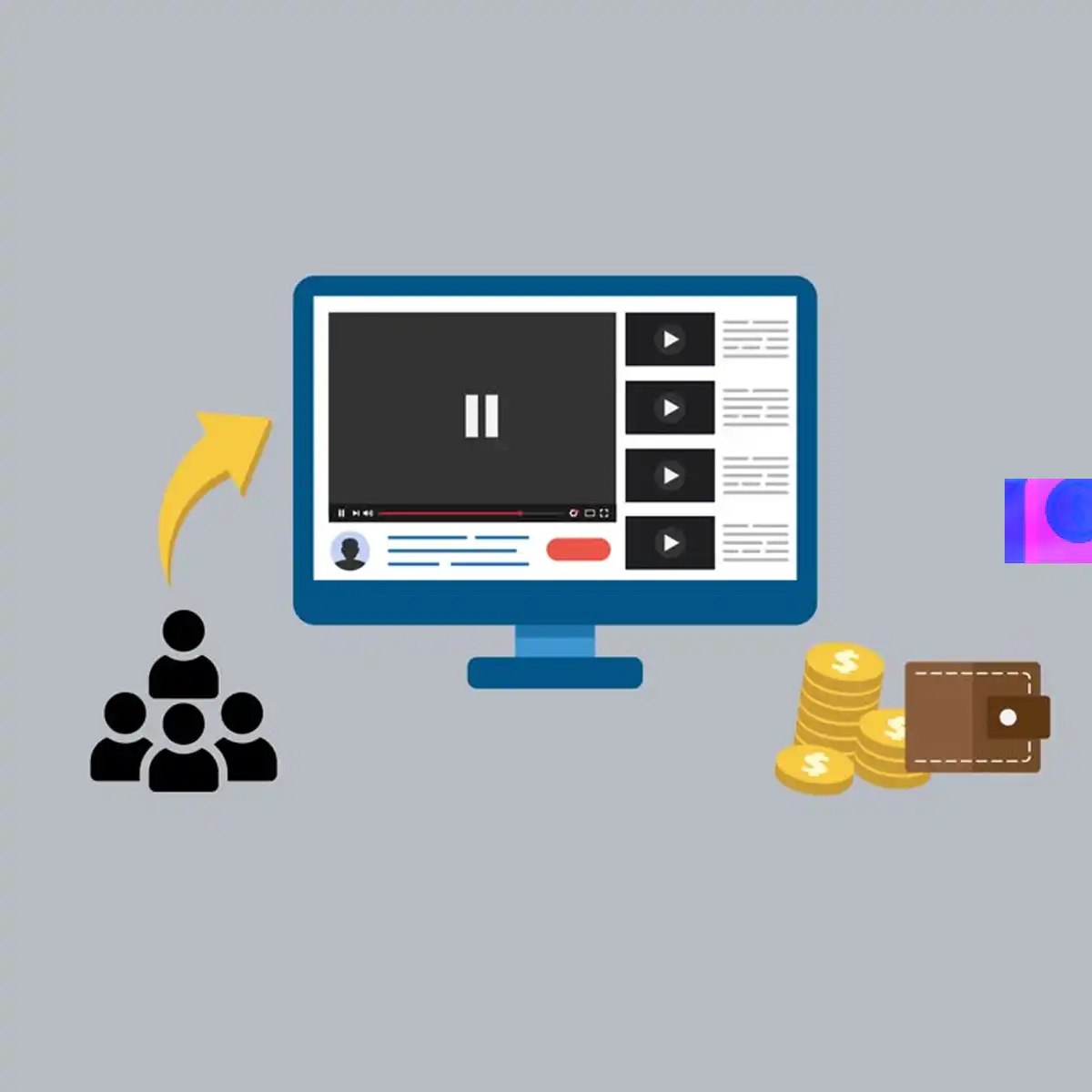Attention has shifted at speed from broadcast and print to online platforms. Video now anchors discovery, consumption, and revenue. Trust is fragile, and regulation has tightened around privacy, transparency, and tax. For SEO, content, and growth teams, this means a reset. Models that rent reach struggle. Models that build owned audiences and first-party data gain strength. What follows sets the context and then maps proven ways to turn attention and authority into predictable revenue.
The platform reset and the rise of video
Online video captures a growing share of daily media time. YouTube sits beside the largest broadcasters for reach and minutes watched, with viewing on living room TVs replacing linear schedules. Short video dominates under-25s on TikTok and Instagram. Social platforms reduce external link distribution, so referral traffic from legacy feeds declines. Advertising budgets follow attention. UK video display outpaces broader digital growth. Any monetisation plan that ignores video underperforms. Treat video as a core format, with search, short, and long content working together.
Trust economy and authenticity
Audiences report flat or declining trust in online information. The spread of low-effort content and synthetic content increases scepticism. Signals that raise trust now carry direct commercial value: clear identity, defensible expertise, transparent sourcing, and responsive community management. Brands shift from mega influencers to smaller subject experts who convert better and carry less risk. The practical outcome is an authenticity premium. Paid memberships, expert courses, and premium newsletters outperform shallow reach plays because they bundle access, evidence, and consistent value.
Regulatory change and first party data
Privacy rules narrow lawful tracking. Valid consent is required for non-essential cookies. “Consent or pay” models attract scrutiny and must present a genuine choice. Influencer disclosures must be explicit and prominent. Platforms share liability with creators and brands for unclear labelling. Tax reporting expands across digital platforms, and all online revenue streams are taxable above allowances. The net result is simple. Third-party data weakens. First-party data rises. Build an email list, a member list, and direct relationships. This is not a campaign tactic but a core risk control.
Advertising models overview
Advertising converts attention into income quickly. It funds early content growth and scales for established properties. Returns depend on traffic, niche, and access to premium demand. Programmatic supports the early stage. Premium managed networks raise RPMs for sites that hit entry thresholds. Large publishers combine video, high viewability placements, and direct deals to lift yield.
Model 1 programmatic and premium display advertising
Display ads pay on impressions and clicks. Returns hinge on session volume, geography, and ad quality. Entry networks such as AdSense are easy to join but pay less. Premium managers such as Mediavine and Raptive require traffic thresholds and reward with stronger RPM. Use a simple planning equation to set targets: Revenue = (Monthly Sessions ÷ 1000) × RPM. Work backwards from income goals to content and SEO targets. Improve Core Web Vitals, viewability, and ad layout to protect user experience and yield. Diversify traffic to reduce algorithm shocks. Run a compliant consent banner to protect ad cookies and analytics.
Risks. Algorithm updates can reduce search traffic. Privacy changes can reduce addressability. Consent fatigue can lower fill.
Mitigation. Build an email audience, add video inventory, raise on-site engagement, and qualify for premium networks as early as possible.
Model 2 affiliate and partnership marketing
Affiliate marketing pays for performance. Partnerships expand this into broader collaborations that reward influence across the journey, not just last click. Choose programs with aligned economics, reliable tracking, and clear rules. Networks such as Awin, CJ, and Impact provide access at scale and support first-party tracking. High intent content converts best: hands-on reviews, comparison pages, calculators, and setup guides. State relationships clearly to meet consumer protection rules. Protect against program risk by promoting multiple non-competing merchants.
Risks. Commission cuts, cookie loss, attribution gaps.
Mitigation. Prefer programs with server-to-server tracking, add unique value (testing, data, tools), and balance merchants to avoid single point failure.
The creator economy direct to fan revenue
Direct payments reduce dependency on ad markets and platform feed volatility. The mix includes platform native features, independent memberships, and paid newsletters. The operating principle is simple. Convert a small, engaged slice of your audience into paying supporters with clear benefits and consistent delivery.
Model 3 platform native creator tools
YouTube memberships, Super Chat, and ads create blended income. TikTok offers creator rewards and live gifting. Twitch focuses on live subscriptions, Bits, and ads. These tools convert best during live or scheduled events where recognition and interaction matter. Treat live sessions as “appointment to view” slots with a tight run of show, prompts for support, and visible perks.
Risks. Policy shifts, demonetisation, or account actions can erase income.
Mitigation. Use these tools to grow, but move viewers to owned channels, especially email.
Model 4 direct subscriptions and memberships
Platforms such as Patreon, Memberful, and Ko-fi enable recurring payments for exclusive content, community, and access. Define a value ladder: public content builds reach, member content solves deeper problems, and top tiers offer direct access or small group sessions. Publish a reliable cadence. Focus on retention mechanics: welcome sequences, member spotlights, quarterly roadmaps, and annual plan incentives.
Risks. Churn and delivery fatigue.
Mitigation. Plan seasonal themes, batch content, invite member contributions, and use annual billing to stabilise cash flow.
Model 5 paid newsletters and premium content
Paid newsletters turn first-party data into revenue. Substack takes a revenue share; Beehiiv charges flat SaaS fees with 0% platform cut on subscriptions. A freemium model works well. Grow the free list with helpful insights and original analysis. Convert a fraction to unlock paid content, tools, or community access. Use referral programmes, cross promotions, and lightweight ads to grow the free list at low cost.
Risks. Inbox competition and topic fatigue.
Mitigation. Tighten the niche, add proprietary charts or benchmarks, and keep a clean send cadence.
Fun fact: Email remains one of the highest ROI channels in marketing because it routes around third-party algorithm changes and gives direct delivery to opted-in readers.
E commerce and product sales overview
Selling solutions, not attention, lifts margins. Digital goods scale cleanly. Physical goods create brand depth but add logistics. Marketplaces offer reach with fees and rules. Owned stores offer control with setup effort. Choose the path that matches skills, capital, and appetite for operations.
Model 6 selling digital products and online courses
Ebooks, templates, software, presets, and courses deliver high gross margins once created. Validate demand before you build. Pre-sell with a clear promise and delivery date. If conversion clears your threshold, produce the asset. Course platforms such as Kajabi and Teachable handle hosting, checkout, and email. Digital storefronts such as Gumroad and Lemon Squeezy simplify sales; MoR options handle VAT collection for cross-border trade.
Launch with a simple funnel: waitlist, preview, early bird, main cart, and last chance. Support with live sessions, case tutorials, and a 14 day guarantee to reduce friction. Add an evergreen path after launch with an email sequence and a lead magnet that matches the product outcome.
Risks. Weak product market fit, refund spikes, piracy.
Mitigation. Validate with paid pilots, ship updates, watermark assets, and bundle community access that piracy cannot copy.


Model 7 direct to consumer ecommerce
D2C stores on Shopify or WooCommerce provide branding control and data access. Pick a focused product line with clear positioning and repeat purchase or strong referral dynamics. Operate to a landing page playbook: value prop above the fold, proof, clear pricing, delivery terms, and an obvious primary action. Use SEO for evergreen queries, paid search for intent capture, and paid social for demand creation. Invest in post-purchase flows, upsells, and returns handling to protect margin and reviews.
Risks. Logistics complexity and ad cost volatility.
Mitigation. Tighten SKU count, negotiate fulfilment, build email and SMS flows, and grow organic traffic to lower blended CAC.
Model 8 selling on marketplaces
Marketplaces such as Etsy deliver ready buyers for handmade, vintage, and craft supply categories. Optimise titles, tags, and photography for on-platform search. Track conversion from views to purchases to prioritise listings that deserve ads. Use marketplace momentum to seed an email list and social following, then introduce an owned store for repeat customers.
Risks. Fee pressure, policy changes, search algorithm shifts.
Mitigation. Treat marketplaces as acquisition channels. Build brand assets off-platform to preserve lifetime value.
Service based models overview
Selling expertise converts credibility into income. It scales linearly at first, then fuels product creation. Productised services reduce scoping friction and raise utilisation. Case studies win deals. Clear pricing and strong process retain clients.
Model 9 professional services and consulting
Position around a specific outcome: technical SEO audits, analytics migrations, content operations, CRO playbooks, or paid search restructuring. Publish evidence-heavy articles, teardown threads, and conference talks. Price by project for discrete deliverables, by retainer for ongoing work, or by performance where you control key levers and measurement is clean. Qualify hard. Say no when inputs do not match the promised outputs.
Risks. Capacity limits and client concentration.
Mitigation. Productise a core offer, add training, and spin out a course or toolkit to capture non-bespoke demand.
Model 10 software as a service
SaaS trades code for recurring revenue. Success depends on a tight problem definition, a simple onboarding, and strong retention. Choose pricing that maps to customer value: tiered plans, usage based billing, or a freemium gateway with clear upgrade paths. Go to market with content, SEO, partner integrations, and outbound for higher contract values. Track MRR, LTV to CAC ratio, payback period, and churn. Build a customer success loop to reduce cancellations and expand accounts.
Risks. High upfront build cost and slow early traction.
Mitigation. Ship a narrow MVP, win a reference cohort, and compound with integrations and templates that lower time to value.
The 2025 monetisation matrix
Use this high level view to compare options and sequence them sensibly.
| Model | Primary Revenue | Revenue Potential | Upfront Cost | Scalability | Audience Need | Key Risk |
| Display advertising | CPM or CPC | £ to £££ | £ | High | High for profit | Algorithm shifts |
| Affiliate and partnerships | Commission or CPA | £ to ££££ | £ | High | Medium | Programme changes |
| Platform native tools | Rev share | £ to £££ | £ | Medium | Medium | Policy changes |
| Direct memberships | Recurring subs | ££ to ££££ | ££ | High | Medium | Churn |
| Paid newsletters | Recurring subs | ££ to ££££ | £ | High | Medium | Inbox fatigue |
| Digital products and courses | One off sales | ££ to £££££ | ££ | Very high | Medium | Fit risk |
| D2C ecommerce | Product sales | ££ to £££££ | £££ | High | Low | Margin pressure |
| Marketplaces | Product sales | £ to £££ | £ | Medium | Low | Fees and control |
| Professional services | Fees and retainers | £££ to ££££ | £ | Low | Low | Capacity |
| SaaS | Recurring subs | £££ to £££££ | £££££ | Very high | Low | Churn |
Building a diversified monetisation portfolio
Think in layers. Layer 1 builds reach and cash flow with programmatic advertising and affiliate marketing. Layer 2 converts fans with memberships, paid newsletters, and platform tools to add stable recurring revenue. Layer 3 sells high-value solutions with digital products, D2C, consulting, and SaaS. Each layer reduces risk from the one below and raises average revenue per user. Sequence by capability and audience maturity, not fashion.
Execution path: set a single economic North Star, such as revenue per subscriber or contribution margin. Instrument analytics to tie content, channels, and offers to that metric. Run quarterly planning with clear bets per layer. Kill underperformers quickly. Reinvest in compounding assets: evergreen articles, email flows, courses, and software.
Horizon scanning emerging trends beyond 2025
Generative AI moves from content helper to product layer. Expect paid access to niche agents, automated creative testing, and personalised outputs that feed both ads and commerce. Web3 concepts may resurface in practical forms such as token gated communities and portable memberships where the tech is invisible to users. Most of all, content, community, and commerce continue to merge. The strongest operators will resemble media brands that sell products, or product brands that run media, united by owned data and clear value.
Conclusion and next steps
Online monetisation in 2025 rewards ownership, clarity, and evidence. Build on formats that match how people now consume content, with video and search reinforcing each other. Earn trust by showing your work and standing behind outcomes. Respect privacy rules and make consent a product quality signal. Grow first-party data from day one. Monetise in layers so that no single platform can undo your work. The blueprint is not complicated. Focus on a niche, solve a real problem, measure the full journey, and compound the assets that you control. As the proverb has it, “A good name is better than riches.” In digital markets, a trusted name owned by you is the asset that compounds.




